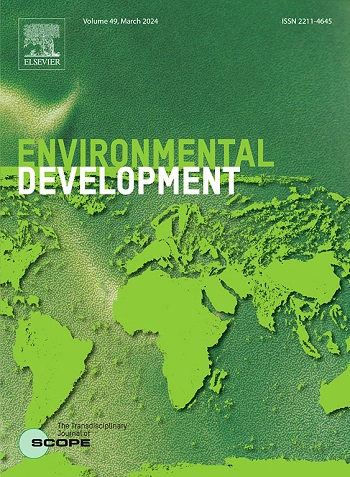沿海社区基于社区的自然资源管理:泰国南部红树林对家庭生计的贡献
IF 5.3
2区 环境科学与生态学
Q2 ENVIRONMENTAL SCIENCES
引用次数: 0
摘要
红树林的退化和丧失降低了这些生态系统对沿海地区当地人民生计作出贡献的能力。以社区为基础的自然资源管理(CBNRM)已被采纳为可持续保护生态系统和改善生计的手段。我们通过以下问题探讨了红树林生态系统中CBNRM与生计之间的联系:家庭以何种方式和在多大程度上受益于红树林?个人和家庭如何通过CBNRM为保护这些福利做出贡献?我们对泰国南部三个沿海社区的150个家庭进行了结构化访谈。我们发现,家庭从红树林中获得了多种生计效益,包括供应(如鱼类、木材)、文化(如家庭和社区凝聚力、社区旅游)、调节(如海岸保护、空气质量调节)和支持(如水生生物多样性的栖息地和苗圃)生态系统服务。在150个家庭中,平均38%的家庭收入来自红树林,90%的家庭认为红树林对他们的生计很重要。此外,我们发现社区成员积极参与并贡献了多个CBNRM活动。参与的一个主要动机是希望继续获得其家庭或社区从红树林获得的生计福利。我们的研究结果表明,CBNRM是当地社区管理红树林和改善生计的有效机制。我们的论文利用生态重要地区的大量家庭样本,对CBNRM下红树林对生计的重要性进行了实证理解。本文章由计算机程序翻译,如有差异,请以英文原文为准。
Community-based natural resource management in coastal communities: The contribution of mangroves to household livelihoods in southern Thailand
The degradation and loss of mangrove forests decreases the capacity of these ecosystems to contribute to the livelihoods of local people in coastal areas. Community-based natural resource management (CBNRM) has been adopted as a means to sustainably conserve ecological systems and improve livelihoods. We explored the links between CBNRM and livelihoods in mangrove ecosystems by asking: In what ways and to what extent do households benefit from mangrove forests? and How do individuals and households contribute to the protection of these benefits, through CBNRM? We conducted structured interviews in 150 households across three coastal communities in southern Thailand. We found that households gained multiple livelihood benefits from mangrove forests, which included provisioning (e.g., fish, timber), cultural (e.g., family and community cohesiveness, community-based tourism), regulating (e.g., coastal protection, air quality regulation), and supporting (e.g., habitats and nursery grounds for aquatic biodiversity) ecosystem services. Across 150 households, an average of 38 % of household income derived from mangroves, and 90 % of households perceived mangroves to be important for their livelihoods. Additionally, we found that community members actively participated in and contributed to multiple CBNRM activities. A primary motivation to participate included the desire to maintain access to livelihood benefits that their household or community enjoyed from the mangroves. Our findings suggest that CBNRM is an effective mechanism by which local communities can manage mangroves and improve livelihoods. Our paper contributes an empirical understanding of the importance of mangroves for livelihoods under CBNRM using a large sample size of households in an ecologically important region.
求助全文
通过发布文献求助,成功后即可免费获取论文全文。
去求助
来源期刊

Environmental Development
Social Sciences-Geography, Planning and Development
CiteScore
8.40
自引率
1.90%
发文量
62
审稿时长
74 days
期刊介绍:
Environmental Development provides a future oriented, pro-active, authoritative source of information and learning for researchers, postgraduate students, policymakers, and managers, and bridges the gap between fundamental research and the application in management and policy practices. It stimulates the exchange and coupling of traditional scientific knowledge on the environment, with the experiential knowledge among decision makers and other stakeholders and also connects natural sciences and social and behavioral sciences. Environmental Development includes and promotes scientific work from the non-western world, and also strengthens the collaboration between the developed and developing world. Further it links environmental research to broader issues of economic and social-cultural developments, and is intended to shorten the delays between research and publication, while ensuring thorough peer review. Environmental Development also creates a forum for transnational communication, discussion and global action.
Environmental Development is open to a broad range of disciplines and authors. The journal welcomes, in particular, contributions from a younger generation of researchers, and papers expanding the frontiers of environmental sciences, pointing at new directions and innovative answers.
All submissions to Environmental Development are reviewed using the general criteria of quality, originality, precision, importance of topic and insights, clarity of exposition, which are in keeping with the journal''s aims and scope.
 求助内容:
求助内容: 应助结果提醒方式:
应助结果提醒方式:


